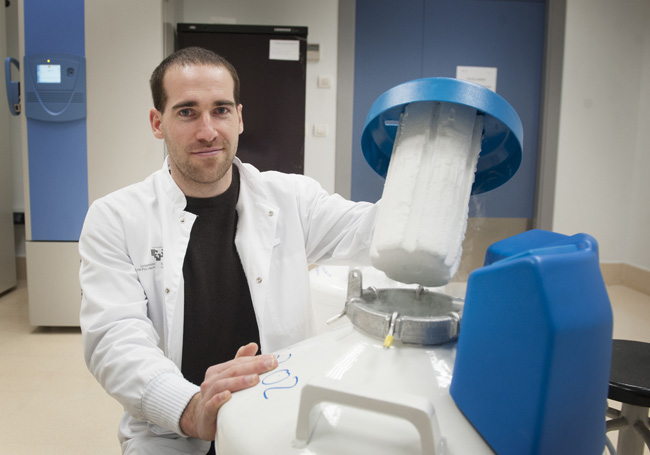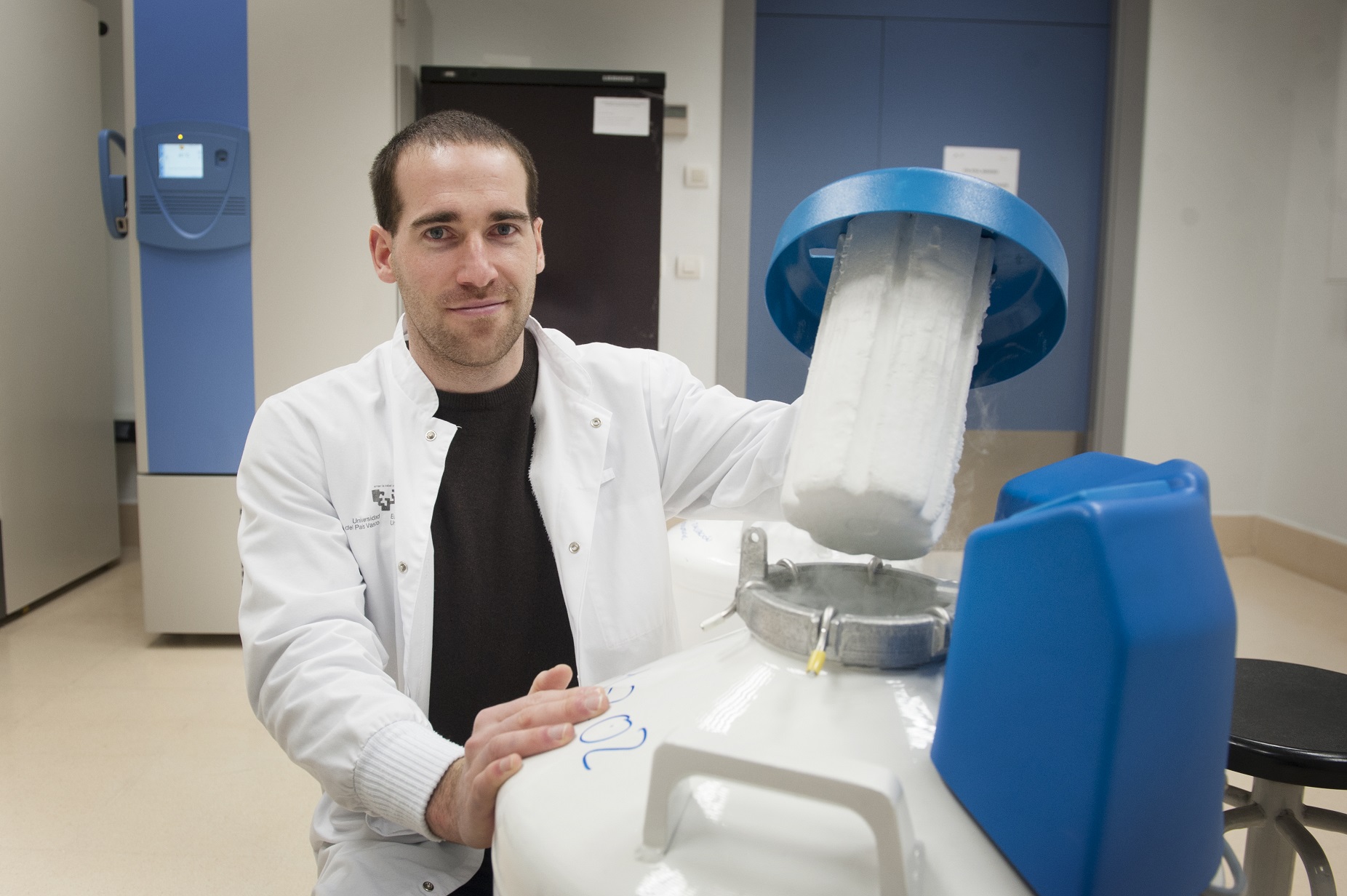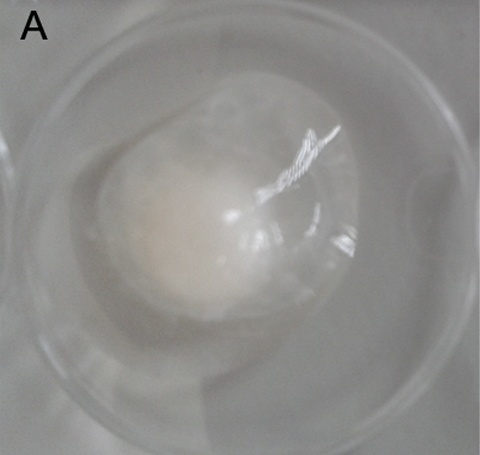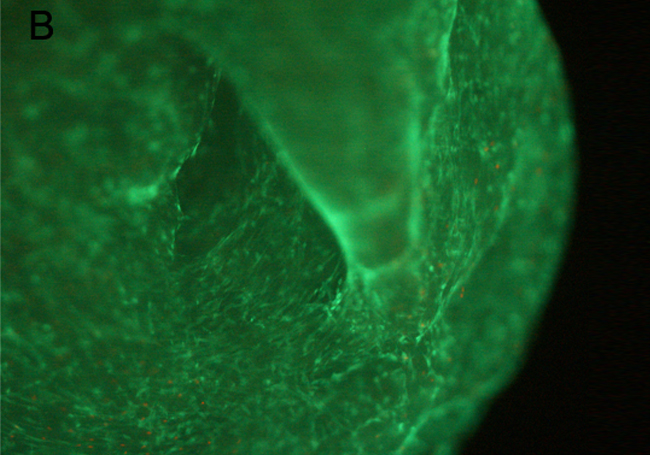The work is part of the PhD thesis by Haritz Gurruchaga, who belongs to the UPV/EHU’s NanoBioCel group, and focusses on optimizing the processes to store encapsulated cells by means of slow cryopreservation. Mesenchymal stem cells are being increasingly used for treating various diseases.
-

Ferreirak eta Bengoetxeak beren programak aurkeztu dituzte UPV/EHUko Klaustroan
-

UPV/EHUko 19 diziplina, munduko 500 onenen artean, Shanghaiko rankingaren arabera
-

Zientzia, Ingeniaritza eta Arkitekturako monografiarik onena
-

Medikuntza birsortzailearen etorkizunari buruzko gakoak
-

Beste pertsona bat al gara beste hizkuntza bat hitz egitean?
Cryopreservation of Stem Cells
A piece of research by the UPV/EHU-University of the Basque Country shows that the beneficial characteristics of stem cells can be preserved after they have been stored at low temperatures
- Research
First publication date: 25/01/2018

The journal Scientific Reports has recently published the article ‘Cryopreservation of human mesenchymal stem cells in an allogeneic bioscaffold based on platelet-rich plasma and synovial fluid’. The work is part of the PhD thesis by Haritz Gurruchaga, who belongs to the UPV/EHU’s NanoBioCel group, and focusses on optimizing the processes to store encapsulated cells by means of slow cryopreservation. The thesis is being co-supervised by the UPV/EHU professor José Luis Pedraz, and Jesús Ciriza, of CIBER BBN.
Menenchymal stem cells are pluripotent, adult cells with a fibroblast-like morphology and the capacity to differentiate into various cell lines, such as chondrocytes, osteocytes and adipocytes, among others. Their use in treating different kinds of diseases has been growing considerably over the last few decades. One of the applications in which they are being used (still in the clinical trial phase) is to treat osteoarthritis, which is characterised by the gradual degeneration of the joint cartilage and surrounding tissue. The latest studies appear to show that these cells are capable of regenerating the damaged tissue and changing the surrounding communication of the inflamed tissue, and have the potential to reduce the pain caused by this disease. When cartilaginous tissue is treated, various studies have described the stem cells derived from the synovial liquid as displaying characteristics superior to those extracted from other tissue types.
The Arthroscopic Surgery Unit (UCA) located at the Hospital Vithas San José in Vitoria-Gasteiz, headed by Mikel Sánchez, has produced a scaffold or matrix that has displayed some very favourable properties for the cultivation and growth of these cells. The matrix is made from plasma rich in platelets, synovial liquid and mesenchymal stem cells derived from the synovial liquid of the patient him-/herself. The formation of this biosystem is straightforward and offers the advantage that it does not need the cell to be isolated from the synovial liquid, which would increase the cost and time involved in producing it. In this case, patients with osteoarthritis need treatment more than once during the disease and these cells have been found to lose some of their beneficial properties as the age of the patient increases. So preserving the biosystem with the mesenchymal stem cells, after they have initially been extracted, could have a great therapeutic potential for treatment in the same patient in the future.
Participation of the UPV/EHU
This is the environment in which the NanoBioCel group of the UPV/EHU’s Faculty of Pharmacy led by Prof José Luis Pedraz is participating. The preservation of different cells in biomaterials is a new line of research being developed by this group and has given rise to the group’s collaboration with the UCA to be able to preserve this biosystem for future use.
There are various methods for preserving cells in biomaterials, but at NanoBioCel they have acquired expertise in slow cryopreservation where the samples have to be treated in advance and are frozen following a specific freezing profile allowing their function and characteristics to be regained after defrosting. The joint work of the two groups has made possible this innovative study into the preservation of one of the most researched cell therapies.
In the work samples from different patients were used to produce the living matrix and the work was conducted on a small scale. Firstly, the matrix optimized by the UCA was shown to be suitable for preserving the mesenchymal stem cells. The second part of the work aimed to determine the optimum composition of the solution and, by combining different molecules, different solutions with considerable protective effects were obtained during freezing. Finally, so as to be sure which was the best combination to preserve the biosystem, more specific tests were run to determine the functionality of the cells that would undertake to repair the tissue; it was confirmed that their characteristics would not be lost during storage at low temperatures. So it has been confirmed that using this biosystem it is possible to preserve the beneficial characteristics of the cells and of the matrix in which they are located. So this work opens a new door for preserving mesenchymal stem cells because it proposes a new, straightforward procedure for this, thus reducing the cost and complexity of the processes, which are factors that frequently hamper bringing the advances offered by these therapies to the clinic.
Bibliographic reference
- Cryopreservation of Human Mesenchymal Stem Cells in an Allogeneic Bioscaffold based on Platelet Rich Plasma and Synovial Fluid
- Scientific Reports 7, Article number: 15733 (2017)
- DOI: 10.1038/s41598-017-16134-6






